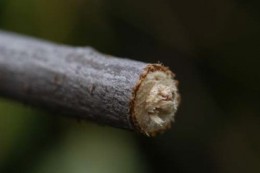This post is from Ward Upham, originally on the KSU Hort News.
We are starting to see damage from twig girdlers as evidenced by fallen twigs up to 3 feet long. The beetle Oncideres cingulata is most likely the culprit. Host trees include elm, oak, linden, hackberry, apple, pecan, persimmon, poplar, sour gum, honey locust, dogwood, and some flowering fruit trees. This insect is distributed throughout the eastern United States from New England to Florida and as far west as Kansas and Arizona. Adults are long-horned beetles with a grayish-brown bodies that are stout and cylindrical. The larvae are also cylindrical with small heads and shiny exteriors. Larvae can be up to an inch long and are light brown to brownish-gray.
Girdled twigs often remain on the tree until a strong wind blows them down. Large infestations can result in a high percentage of girdled twigs. Though this may reduce the vigor and appearance of the tree, the overall effect on the tree’s health is not severe. Twigs are unsightlyand do not fall all at once, so clean up is a drawn out process.
This beetle has a one-year life cycle. Late in the growing season, the female deposits eggs in small scars chewed through the bark and then chews a continuous notch around the twig, girdling it. The notch is cut below the site of egg deposition apparently because the larva is unable to complete development in the presence of large amounts of sap. Girdled twigs die and fall to the ground where the eggs hatch.
Girdled twigs look like a beaver has chewed on them, only in miniature. The outside of the twig is smoothly cut, but the center of the twig appears broken. The larvae begin feeding on dead wood inside the twigs the following spring and continue through most of the summer. Pupation takes place inside the feeding cavity. Development is completed during August when the adult emerges to repeat the cycle.
Though adults feed on the bark of host twigs, damage is minimal until the female starts girdling. Chemical control is impractical, so gather and dispose of fallen twigs in the fall or spring to destroy the larvae inside. Often, natural mortality is high because fallen twigs are excessively dry or carry too many larvae per twig.

